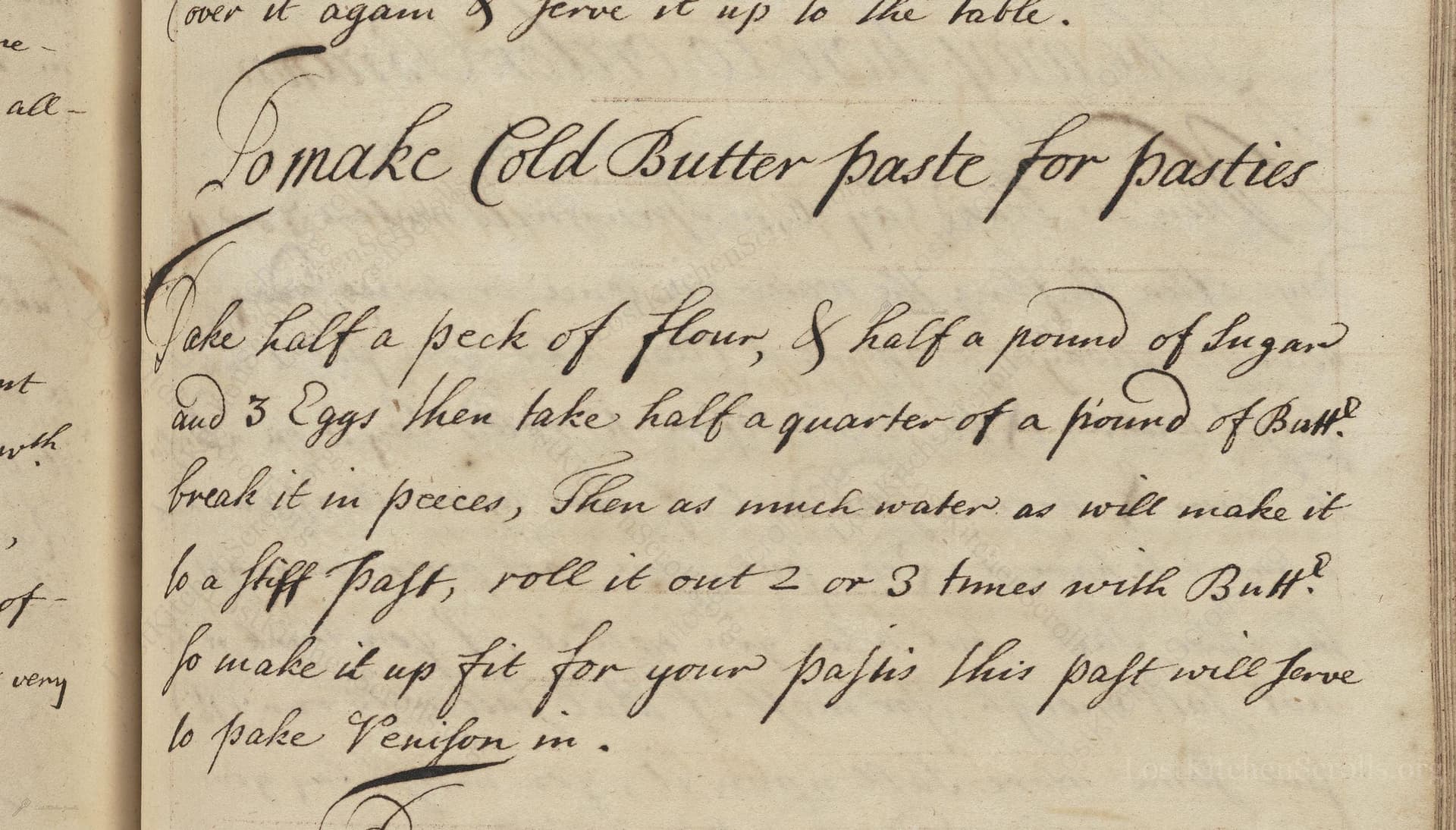To Make Cold Butter Paste For Pasties
From the treasured pages of Various Cookeries
Unknown Author

To Make Cold Butter Paste For Pasties
"Take half a peck of flour, & half a pound of sugar and 3 Eggs then take half a quarter of a pound of Butter break it in peeces, Then as much water as will make it to a stiff past, roll it out 2 or 3 times with Butter to make it up fit for your pastrie this past will serve to bake Venison in."
Note on the Original Text
Written in the succinct, assumption-laden style of early modern English manuscripts, this recipe leaves many details implicit—quantity guesses, technique hints, and no baking times or temperatures. Spelling reflects period phonetics and abbreviation, such as 'Butt.r' for butter. Numerals were often mixed with words, and punctuation was minimal. The instructions expect the cook to understand pastry basics, like layering butter through repeated rolling.

Title
Various Cookeries (1690)
You can also click the book image above to peruse the original tome
Writer
Unknown
Era
1690
Publisher
Unknown
Background
A delightful glimpse into late 17th-century kitchens, this book brims with recipes, methods, and culinary wisdom passed down through generations, capturing the essence of historical gastronomy.
Kindly made available by
Folger Shakespeare Library
This recipe for 'Cold Butter paste for pasties' hails from the late 1600s in England—a time when meat-filled pastries were culinary mainstays, especially for preserving and presenting rich meat such as venison. Large, sturdy pasties encased meats to keep them moist and safe for travel or extended storage, essential in an era before refrigeration. The sugar in the pastry points to a taste for slightly sweet doughs in the late Stuart period, when sweet-savory combinations were fashionable in aristocratic and middle-class households.

The cook would have used a large wooden trencher for mixing the flour and other ingredients, a knife for cutting the butter into pieces, and likely a rolling pin for rolling out the dough. Mixing was done by hand, and the paste would have been chilled by the cool kitchen air, rather than refrigeration. For baking, heavy earthenware or metal pans were used, often in a wood-fired or coal-fired oven.
Prep Time
40 mins
Cook Time
0 mins
Servings
20
We've done our best to adapt this historical recipe for modern kitchens, but some details may still need refinement. We warmly welcome feedback from fellow cooks and culinary historians — your insights support the entire community!
Ingredients
- 9 lb plain flour (all-purpose flour)
- 8 oz granulated sugar
- 3 large eggs
- 4 oz cold unsalted butter (plus 4 oz more for rolling in)
- 3 cups cold water (approximate, adjust as necessary)
Instructions
- To recreate this Cold Butter Paste for pasties in a modern kitchen, begin by sifting 9 pounds of plain flour with 8 ounces of sugar.
- Make a well in the center and add 3 large eggs, lightly beaten.
- Cut 4 ounces of cold butter into small pieces and rub these into the flour until the mixture resembles coarse crumbs.
- Gradually add about 3 cups of cold water, enough to bring the dough together into a firm, not sticky pastry.
- Turn out onto a floured surface, knead briefly, then roll out the dough.
- Dot with extra cold butter (another 4 ounces), fold up, and roll out again.
- Repeat this process two or three times to create layers, as for puff pastry.
- Chill if necessary.
- Use this rich, robust pastry to encase hearty fillings—traditionally venison, but any robust meat or vegetable filling would also suit.
Estimated Calories
480 per serving
Cooking Estimates
It takes about 40 minutes to prepare the pastry, including mixing, kneading, layering butter, and chilling. The pastry itself doesn't require baking until filled, so there's no actual cook time for this part. Each serving contains an estimated 480 calories. This recipe makes enough pastry for about 20 large pasties.
As noted above, we have made our best effort to translate and adapt this historical recipe for modern kitchens, taking into account ingredients nowadays, cooking techniques, measurements, and so on. However, historical recipes often contain assumptions that require interpretation.
We'd love for anyone to help improve these adaptations. Community contributions are highly welcome. If you have suggestions, corrections, or cooking tips based on your experience with this recipe, please share them below.
Join the Discussion
Rate This Recipe

Den Bockfisch In Einer Fleisch Suppen Zu Kochen
This recipe hails from a German manuscript cookbook compiled in 1696, a time whe...

Die Grieß Nudlen Zumachen
This recipe comes from a rather mysterious manuscript cookbook, penned anonymous...

Ein Boudain
This recipe comes from an anonymous German-language manuscript cookbook from 169...

Ein Gesaltzen Citroni
This recipe, dating from 1696, comes from an extensive anonymous German cookbook...
Browse our complete collection of time-honored recipes



